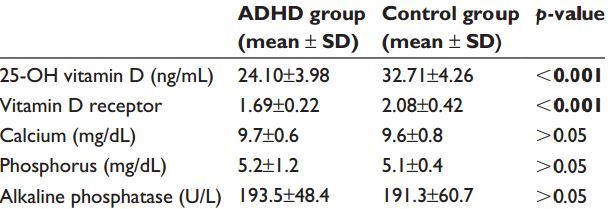ADHD associated with both low vitamin D and poor Vitamin D receptor
Vitamin D and vitamin D receptor levels in children with attention-deficit/hyperactivity disorder
Neuropsychiatric Disease and Treatment 2018:14 581-585
Nilfer sahin1 nilfersahin@hotmail.com ,Hatice Altun2 Ergul Belge Kurutas3 Damla Balkan1
1 Dept of Child and Adolescent Psychiatry, Mugla Sitki Kogrnan University, Mugla, Turkey;
2 Dept of Child and Adolescent Psychiatry, Kahramanmaras Sutcu Imam U., Kahramanmaras, Turkey;
3 Dept of Biochemistry, Kahramanmaras Sutcu Imam University, Kahramanmaras, Turkey
📄 Download the PDF from VitaminDWiki

Objective: In this study, we aimed to evaluate vitamin D and vitamin D receptor levels in children with attention-deficit/hyperactivity disorder (ADHD).
Patients and methods: In this cross-sectional study, a total of 80 children including 40 ADHD patients (aged 6-12 years; 28 males and 12 females) and 40 age-, sex-, and season of blood collection-matched controls (aged 6-12 years; 25 males and 15 females) were enrolled. Serum vitamin D and vitamin D receptor levels and calcium, phosphorus, and alkaline phosphatase were measured. The vitamin D receptor levels in the serum were measured using the quantitative sandwich enzyme immunoassay technique.
Results: Serum vitamin D and vitamin D receptor levels were found to be significantly lower in children with ADHD compared to healthy controls. No significant differences were found in serum calcium, phosphorus, and alkaline phosphatase levels. No significant differences were found among the ADHD subtypes in terms of serum vitamin D, vitamin D receptor, calcium, phosphorus and alkaline phosphatase levels.
Conclusion: This study suggests that children with ADHD have lower levels of vitamin D and vitamin D receptor. According to the authors’ knowledge, this is the first study to describe vitamin D receptor levels in ADHD.
Start of Introduction
Characterized by attention deficit and hyperactivity/impulsivity symptoms, attention- deficit/hyperactivity disorder (ADHD) is a neurodevelopmental disorder with childhood onset likely to persist into the adulthood. A comprehensive meta-analysis has estimated its prevalence to be 5.29% .1 It is almost three times more common in men than in women.2 Although it is a common disease, its etiology still remains largely unknown. Family, twin, adoption, and candidate gene studies have shown that genetic factors play a major role in the disease onset.3 In addition, various trace element deficiencies, vitamin deficiencies, polyunsaturated fatty acid deficiencies, and chemical exposures are blamed in its etiology.4 Furthermore, vitamin deficiencies are among the most discussed topics lately. In particular, vitamin D abnormalities are blamed in the etiology.5
